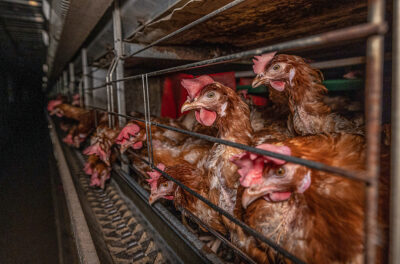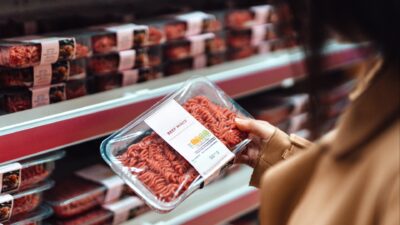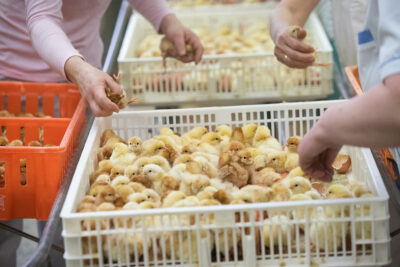Few products cause consumers as much confusion as eggs. There are seemingly unending marketing ploys surrounding their production, leaving the well-meaning shopper at a loss as to what it all means and which egg is the best for chickens. The answer: none of them. Regardless of the production system used, hens in commercial facilities endure massive suffering caused by their genetics and the way they are housed.
WHAT IS COMMERCIAL EGG PRODUCTION?
Though we may want to believe that the eggs we purchase at the supermarket come from hens who live in a coop in a quaint backyard with a wide open space to run and stretch their wings, the reality is that those eggs are laid by hens in an industrial setting. Sometimes this means they are stuffed into a cage with about eight other chickens, while others have the luxury of walking around a massive indoor barn. Regardless of the specific housing system employed, one thing remains constant: the lives of these mother birds are governed by profit and productivity, and little, if any, concern is extended to their welfare.
While many different countries contribute to the 93m tonnes of eggs produced annually around the world, China is responsible for a whopping 38 percent, whereas the United States and India, the next largest producers, account for 7 percent of total production each. Accordingly, China also houses the greatest number of laying hens. In 2017, the country had over 3 billion hens, while India had just under 403 million and the United States was home to almost 376 million.
HOW ARE COMMERCIAL EGGS PRODUCED?
There are three dominant systems used to produce eggs commercially: battery cages, barn systems, and free-range housing. Of these, battery cages are the most common worldwide. Most of the world’s chickens spend their lives in cages with less than a standard A4 sheet of paper’s worth of personal space. This translates into barely enough room to stand, let alone stretch their wings or display other natural behaviours.
Housing is not the only welfare issue associated with egg production. Perhaps one of the most horrifying realities within the industry is that male chicks are regarded as a byproduct. Because male chicks are not able to produce eggs like their sisters, they are gruesomely killed on their first day of life. Contributing to this suffering is the long process of selective breeding by chicken suppliers that has resulted in layer hens that produce a massive amount of eggs and separate breeds raised for their flesh, called broiler chickens. Because of this differentiation, the male layer chicks are not considered worth the cost of feeding and housing them for even the few weeks of life that broiler chickens get before slaughter.
Research has suggested that there is no way to provide high welfare for the chickens within commercial egg production. Within battery cages, hens don’t have the space to stretch their wings and express natural behaviours. However, in barn and free-range housing systems mortality rates are higher, which can be largely attributed to a lack of beak trimming. Though trimming beaks reduces cannibalism, pecking, and thus mortality, it also can lead to lifelong pain and alter the birds’ behaviour.
BATTERY CAGES
Traditional, barren battery cages are still the dominant housing system for laying hens. In the United States, for example, about 70 percent of hens spend their lives in battery cages. Various countries, including the UK, have been moving away from the housing system, largely in response to consumer demand. Though traditional cages were banned in 2012 in the UK, enriched cages persist. Such cages typically provide the birds with a scratch pad and a piece of wood on which to stand. Though they do tend to be slightly larger, more birds are usually crammed into each cage. Instead of switching to cage-free housing systems, most egg producers in the UK swapped, or modified, their existing battery cages to enriched cages following the ban.
More recently, efforts have been made to completely ban battery cages, whether enriched or not, for housing laying hens. So far, however, they have been unsuccessful.
BARN SYSTEMS
Barn systems may sound pleasant, because instead of being housed in a cage with about eight other birds, the hens have free run of a barn. However, the reality is that these systems usually don’t provide much higher welfare for hens than battery cages. Within barn systems, also known as cage-free housing, the chickens often lack sunlight and are still manipulated with artificial lighting systems that make them lay more eggs. In fact, “barn eggs” has been called out as the most misleading label on animal products by Dutch consumers, due to the mismatch between marketing and the reality for the birds.
FREE-RANGE HOUSING
Free-range housing systems are very similar to other industrial egg farming techniques. The only real difference between barn systems and free-range systems is that the massive barns have small holes through which the chickens can access a yard. However, due to the sheer number of chickens housed in a single shed and the fact that they can be territorial many of the hens may never actually see the light of day.
HOW DO COMMERCIAL LAYING HENS LIVE?
Regardless of how they are housed, a commercial laying hen endures significant crowding, broken bones, disease, and mutilation by other birds.
EXTREME CROWDING
Crowding thousands of birds together on a single farm not only compromises animal welfare but also public health. The tight quarters lend themselves perfectly to the spread of disease, not only among the birds themselves but also to humans and other species. In fact, factory farming, and specifically chicken farming, is viewed by many experts as one of the greatest risk factors for the next global pandemic.
ENRICHED CAGES
Chickens in the UK are no longer housed in traditional battery cages per a 2012 law. Instead, they have been switched into slightly larger enriched cages. Though this shift was an attempt to alleviate animal suffering, the reality is that more birds are usually stuffed into each cage and that the enrichment they feature is often little more than a piece of wood to stand on and a small scratching pad.
BRITTLE BONES
Layer hens have notoriously poor bone health, in large part due to the excessive number of eggs they are compelled to lay. The eggs require calcium, some of which is rerouted from building strong healthy bones for the mother hen. The calcium that the mother needs to produce the eggs modern farming demands of her exceeds her reserves by about 30 times.
Weakened bones lead to fractures, with millions of layer hens in the United Kingdom likely suffering from broken keel bones. Just like humans, fractures are painful for birds and can limit activity and their ability to perform natural behaviours.
FEATHER PECKING
Feather pecking is often considered one of the most significant welfare issues for laying hens as it can lead to cannibalism. Traditionally, beak trimming — in which up to a third of the beak is removed — is used to prevent the behaviour.
Realistically, feather pecking is a byproduct of factory farms in which birds don’t have the space they need and take their frustration out on other hens.
SALMONELLA
Though salmonella tends to only kill chicks under a few weeks old, the disease poses a serious health risk for people, infecting thousands in the EU yearly. Because even chickens that have recovered from the disease are still able to shed it in their feces, it is almost impossible to keep it from spreading unless bedding is routinely changed. While this may seem like a low bar, the reality is that most chickens spend their lives on the same feces-covered bedding.
EGG PRODUCTION STATISTICS
The closest wild ancestor of today’s chickens is the Red Jungle Fowl. These birds lay between 10 and 15 eggs per year. By contrast, the average laying hen on a commercial farm has been bred to lay upwards of 300 eggs in a single year. The sheer number of eggs produced is crippling for the mother hen, who is likely to endure weakened and broken bones as a result.
HOW MANY EGGS DOES A COMMERCIAL LAYER LAY A DAY?
Intensive breeding to increase production has significantly increased the number of eggs laid by an individual hen. While in 2002 the average bird laid about 260 eggs every year, as of 2022 that number had jumped all the way up to 300.
HOW MANY EGGS ARE PRODUCED IN BATTERY CAGES?
Over 245m dozen eggs were laid by chickens housed in battery cages, albeit enriched ones, in the UK in 2022.
HOW MANY EGGS ARE PRODUCED IN BARN SYSTEMS?
Roughly 59m dozen eggs were produced in barn systems in the UK during 2022.
HOW MANY EGGS ARE PRODUCED AS FREE-RANGE?
According to government data, of the eggs produced in the UK roughly 534m were considered free-range during 2022. However, due to concern surrounding avian influenza there have been restrictions on chickens’ outdoor access and for part of the year those eggs were relabeled as barn-raised.
Though eggs sold as free-range outnumber those produced using barn or cage systems, it’s important to remember the minimal standards that must be met in order to be considered free-range. Instead of having free and constant access to fields of greenery, the reality is that many of the birds don’t even have the chance to set foot outside.
CONCLUSION
There is no such thing as buying chicken eggs from a grocery store that were laid by happy hens. Whether the eggs are marketed as cage-free or conventional, the hens still endured many of the same problems such as bone fractures and overcrowding.





